Spatiotemporal Mapping of Soil Profile Moisture in Oases in Arid Areas
Abstract
1. Introduction
2. Materials and Methods
2.1. Study Area
2.2. Data
2.2.1. Soil Moisture Data
2.2.2. Remote Sensing Imagery Data
2.3. Methods
2.3.1. Index Construction
2.3.2. Bootstrap Soft Shrinkage Algorithm
2.3.3. Models
2.3.4. Model Evaluation
3. Results
3.1. Descriptive Statistics of Measured Sample Data
3.2. Multi-Layer Feature Variable Selection
3.3. Construction and Comparison of Soil Moisture Retrieval Models
3.4. Soil Moisture Mapping
3.4.1. Soil Moisture Mapping at Different Depths
3.4.2. Soil Moisture Mapping Across Different Years
4. Discussion
4.1. Selection of Feature Parameters
4.2. Performance Evaluation of CNN, LSTM, and CNN-LSTM Models
4.3. Limitations and Future Prospects
5. Conclusions
Author Contributions
Funding
Data Availability Statement
Conflicts of Interest
Abbreviations
| CNN | Convolutional Neural Networks |
| LSTM | Long Short-Term Memory networks |
| SMC | Soil moisture content |
| BOSS | Bootstrap Soft Shrinkage Algorithm |
Appendix A
Appendix A.1
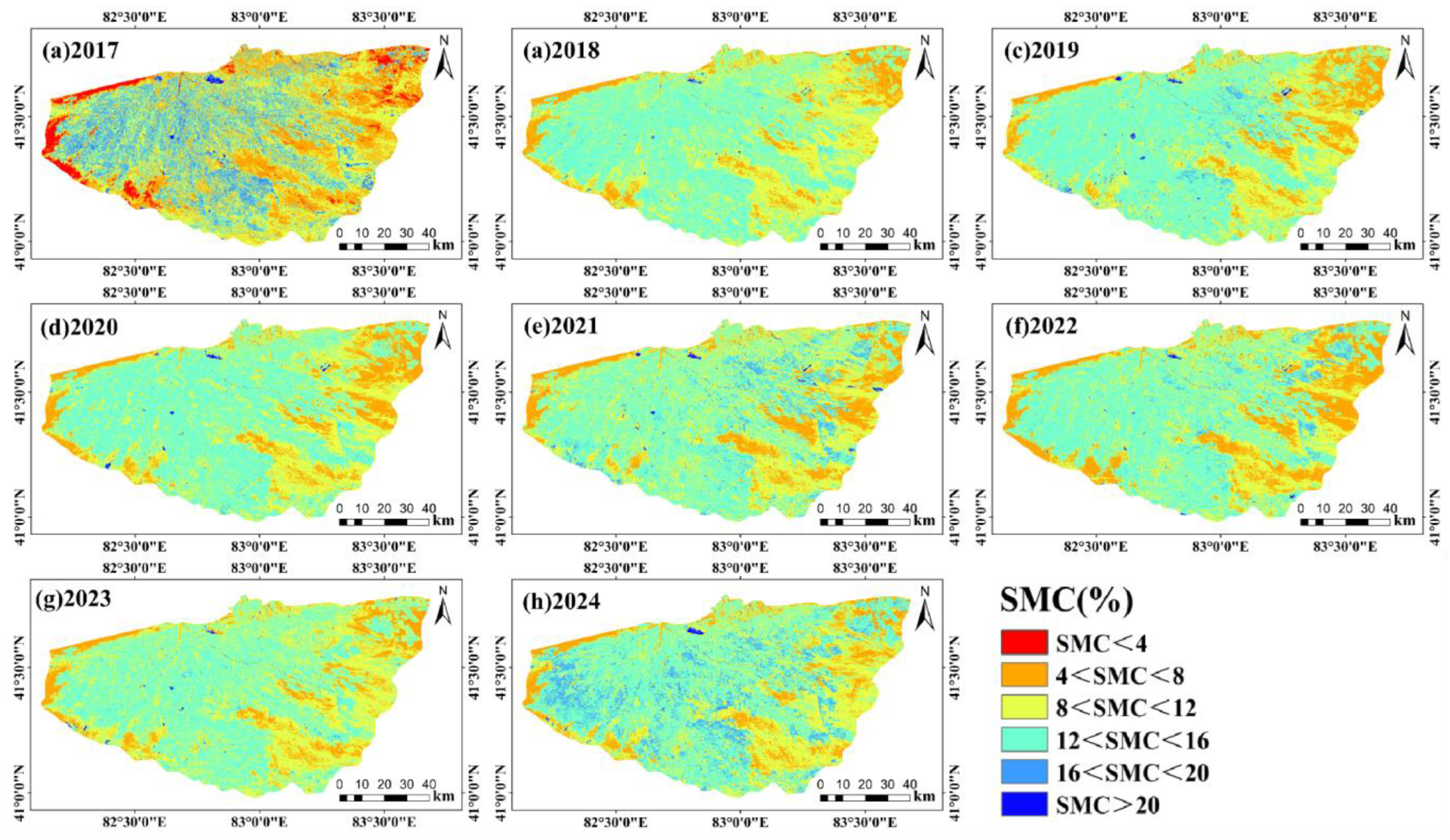
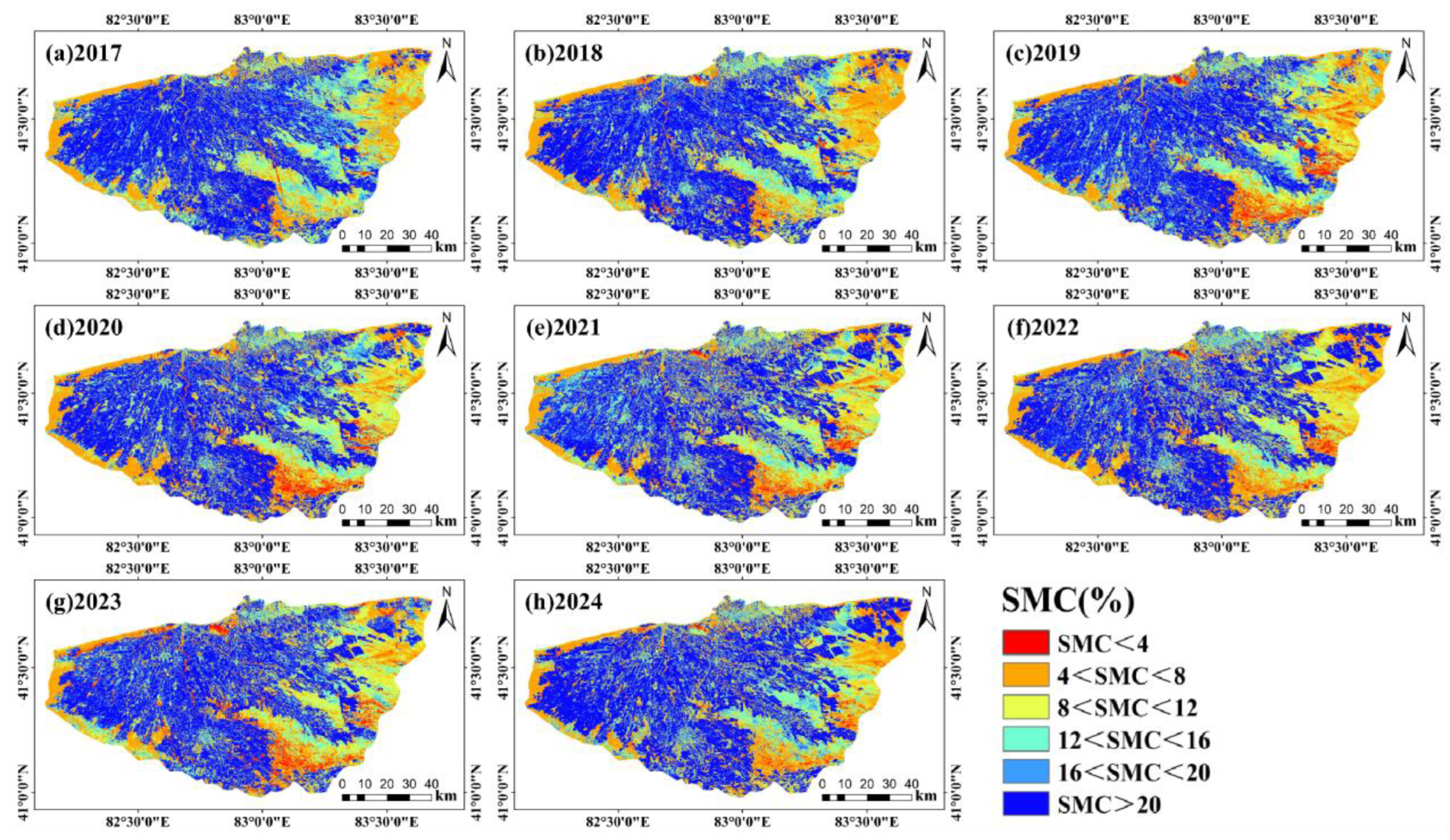

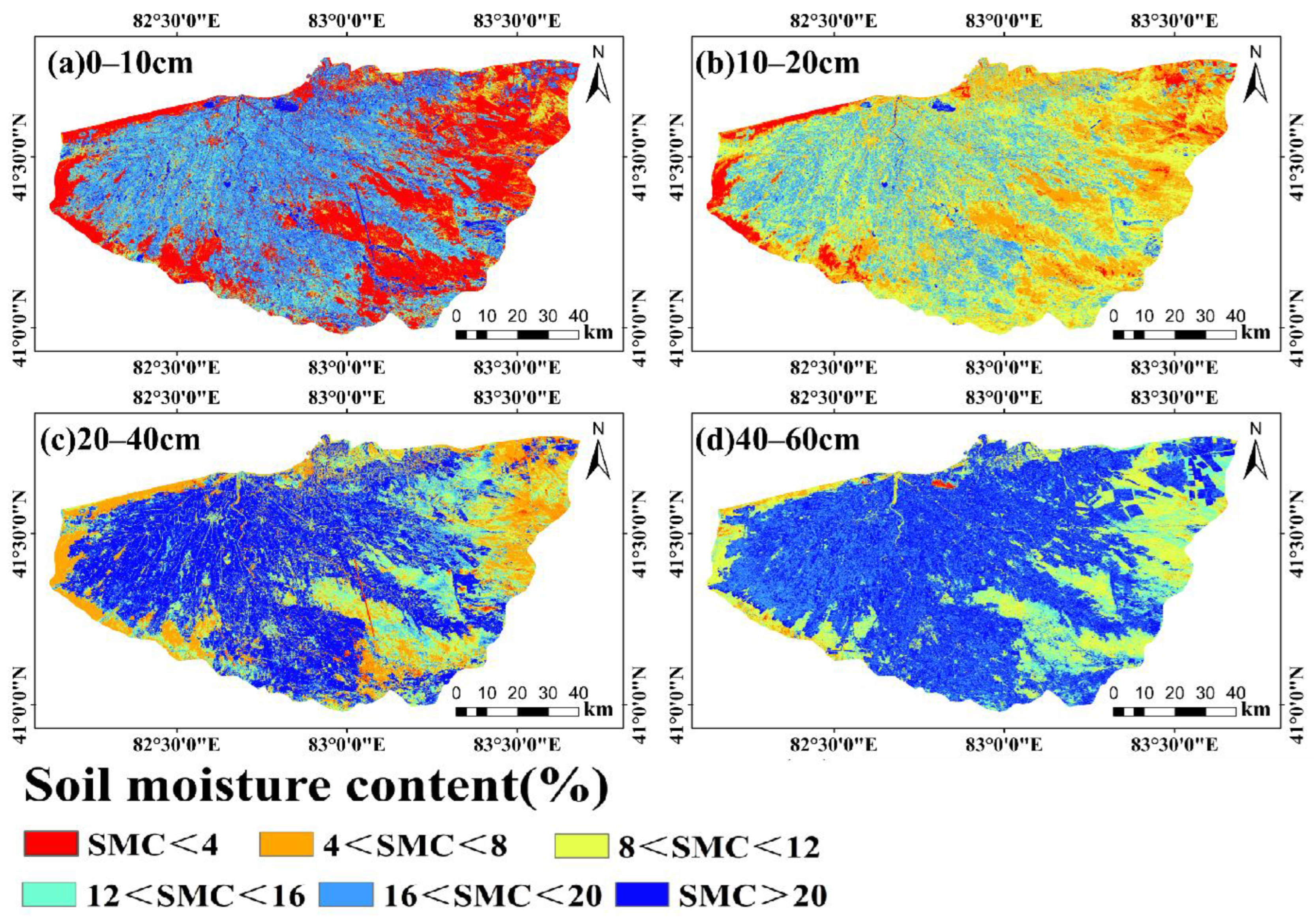


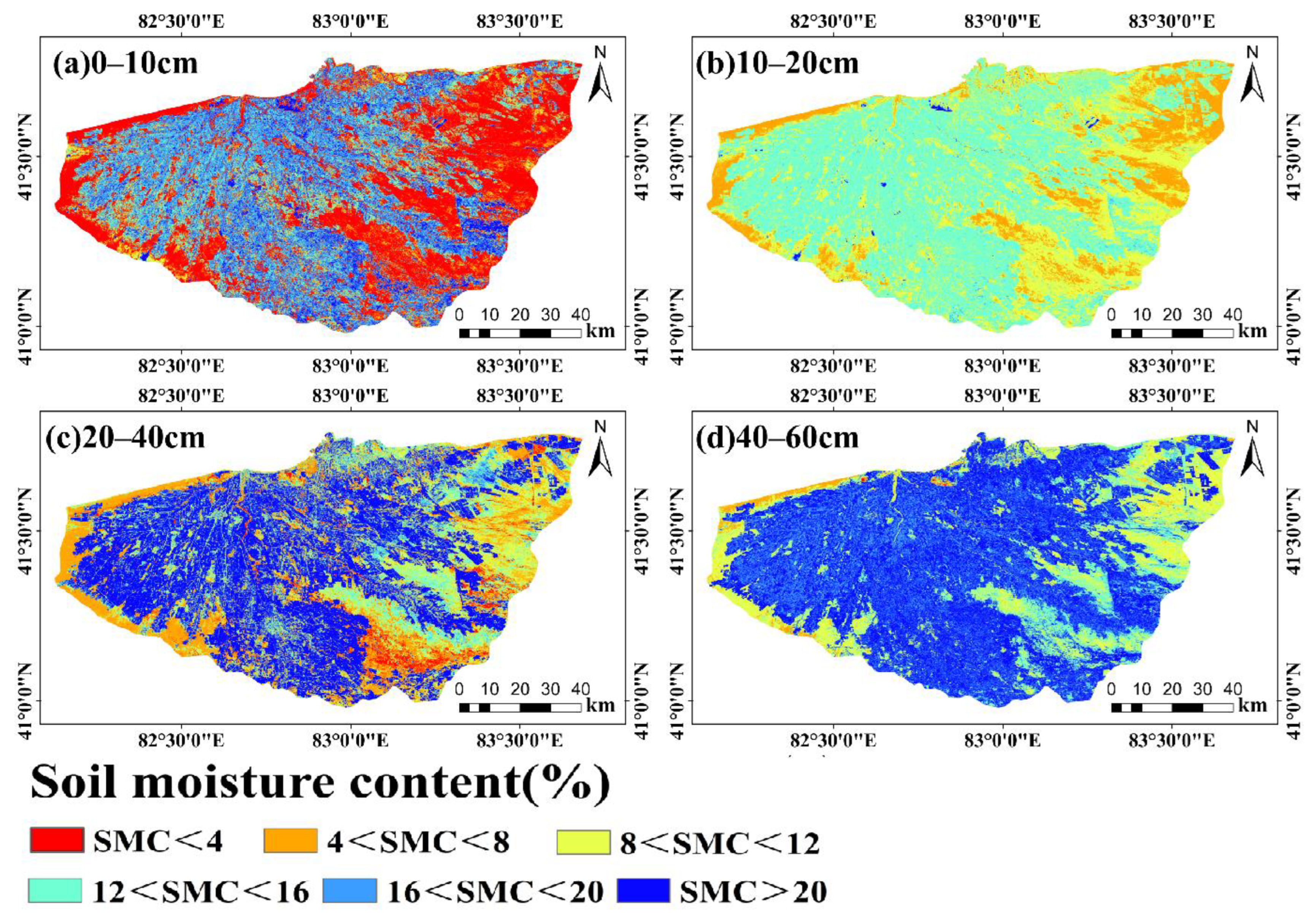

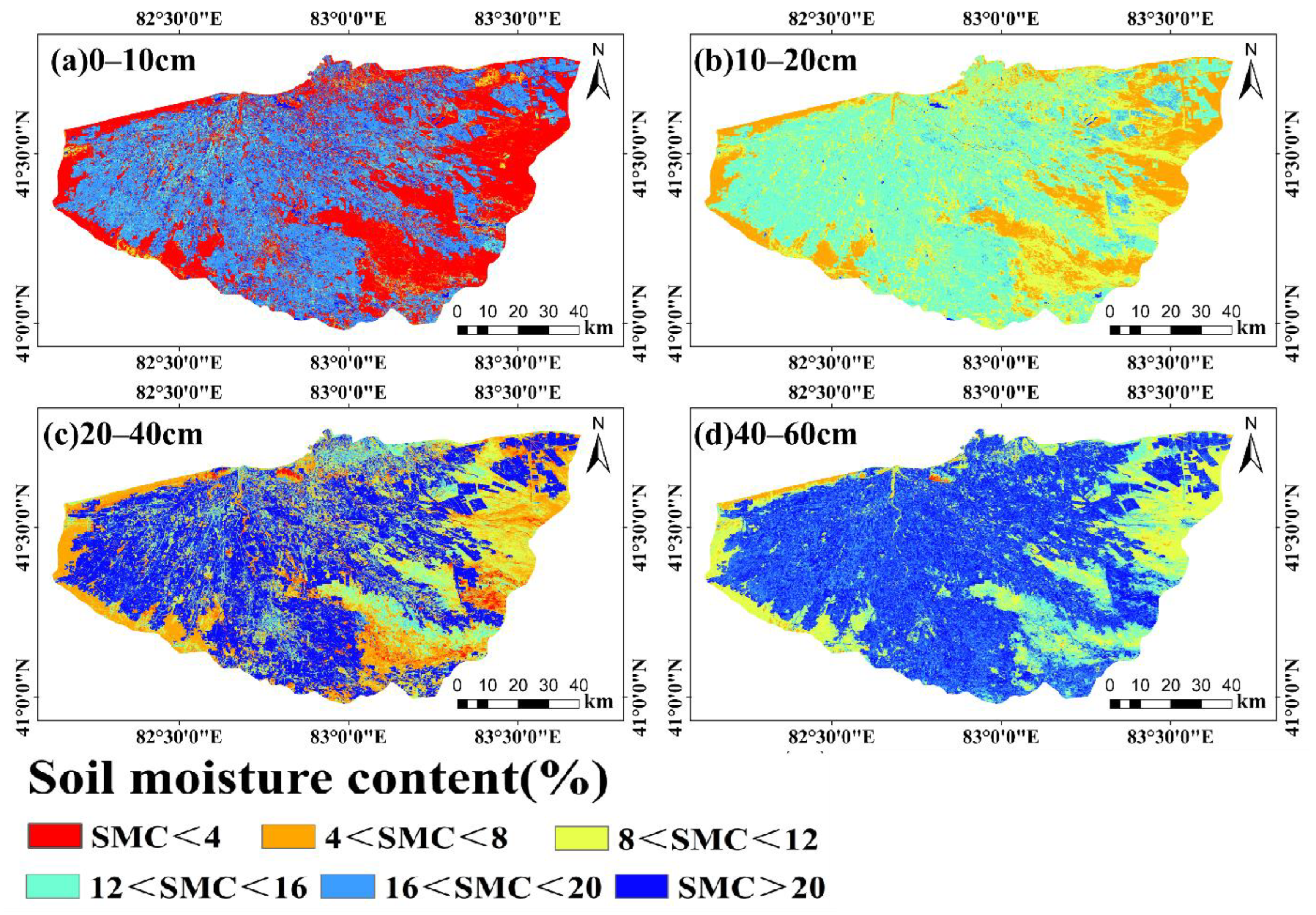
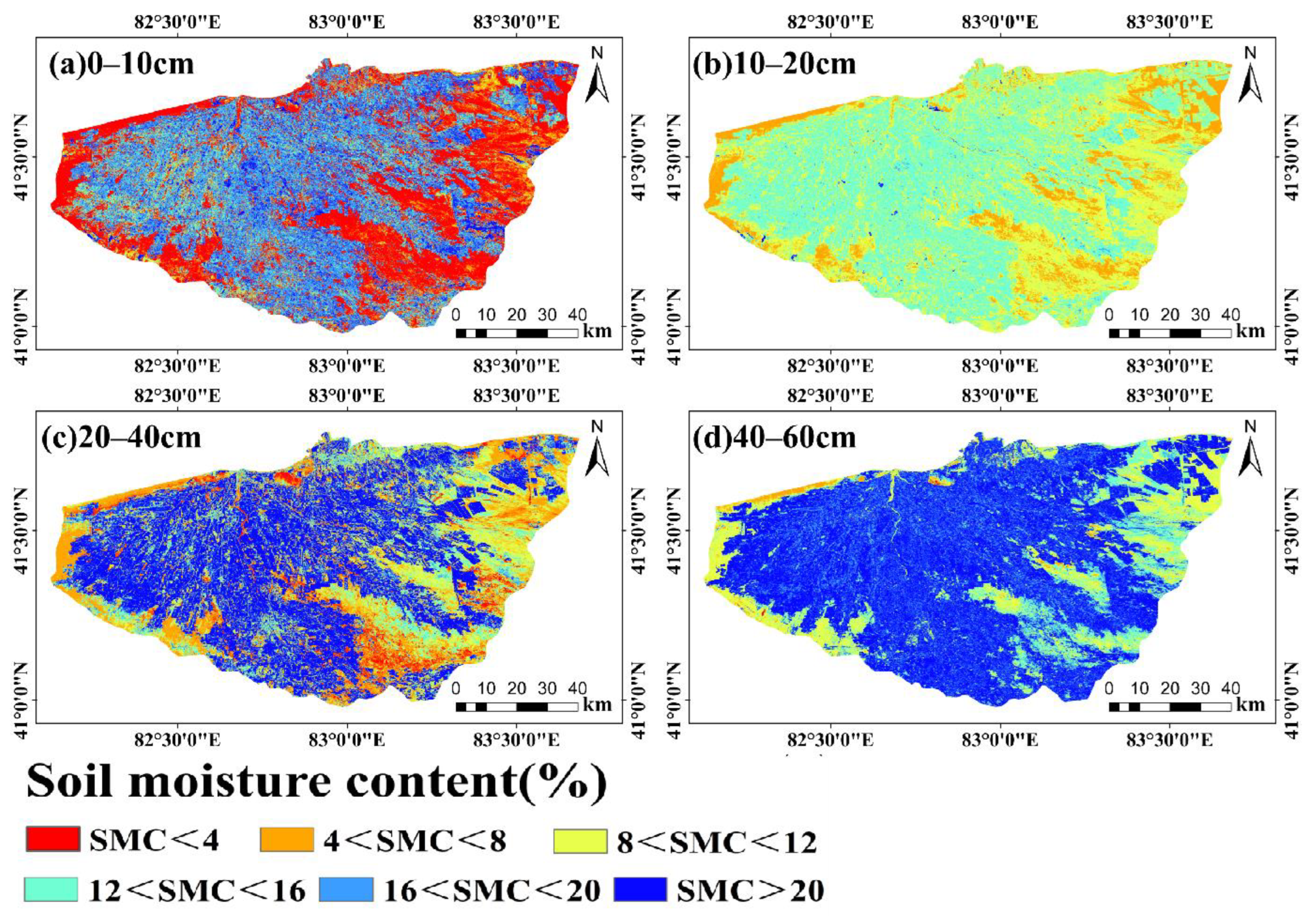
References
- Qin, X.; Pang, Z.; Jiang, W.; Feng, T.; Fu, J. Progress and development trend of soil moisture microwave remote sensing retrieval method. J. Geo-Inf. Sci 2021, 23, 1728–1742. [Google Scholar] [CrossRef]
- Ge, X.; Ding, J.; Jin, X.; Wang, J.; Chen, X.; Li, X.; Liu, J.; Xie, B. Estimating agricultural soil moisture content through UAV-based hyperspectral images in the arid region. Remote Sens. 2021, 13, 1562. [Google Scholar] [CrossRef]
- Wu, Z.; Cui, N.; Zhang, W.; Liu, C.; Jin, X.; Gong, D.; Xing, L.; Zhao, L.; Wen, S.; Yang, Y. Estimating soil moisture content in citrus orchards using multi-temporal sentinel-1A data-based LSTM and PSO-LSTM models. J. Hydrol. 2024, 637, 131336. [Google Scholar] [CrossRef]
- Sreedeep, S.; Reshma, A.; Singh, D. Measuring soil electrical resistivity using a resistivity box and a resistivity probe. Geotech. Test. J. 2004, 27, 411–415. [Google Scholar] [CrossRef]
- Ying, Z. Study on retrieval methods of soil water content in vegetation covering areas based on multi-source remote sensing data. In Proceedings of the 2010 Second IITA International Conference on Geoscience and Remote Sensing, Qingdao, China, 28–31 August 2010; pp. 369–372. [Google Scholar]
- Filgueiras, R.; Almeida, T.S.; Mantovani, E.C.; Dias, S.H.B.; Fernandes-Filho, E.I.; da Cunha, F.F.; Venancio, L.P. Soil water content and actual evapotranspiration predictions using regression algorithms and remote sensing data. Agric. Water Manag. 2020, 241, 106346. [Google Scholar] [CrossRef]
- Brocca, L.; Ciabatta, L.; Massari, C.; Camici, S.; Tarpanelli, A. Soil moisture for hydrological applications: Open questions and new opportunities. Water 2017, 9, 140. [Google Scholar] [CrossRef]
- Balenzano, A.; Mattia, F.; Satalino, G.; Lovergine, F.P.; Palmisano, D.; Peng, J.; Marzahn, P.; Wegmüller, U.; Cartus, O.; Dąbrowska-Zielińska, K. Sentinel-1 soil moisture at 1 km resolution: A validation study. Remote Sens. Environ. 2021, 263, 112554. [Google Scholar] [CrossRef]
- Peng, J.; Albergel, C.; Balenzano, A.; Brocca, L.; Cartus, O.; Cosh, M.H.; Crow, W.T.; Dabrowska-Zielinska, K.; Dadson, S.; Davidson, M.W. A roadmap for high-resolution satellite soil moisture applications–confronting product characteristics with user requirements. Remote Sens. Environ. 2021, 252, 112162. [Google Scholar] [CrossRef]
- Foucras, M.; Zribi, M.; Albergel, C.; Baghdadi, N.; Calvet, J.-C.; Pellarin, T. Estimating 500-m resolution soil moisture using Sentinel-1 and optical data synergy. Water 2020, 12, 866. [Google Scholar] [CrossRef]
- Mengen, D.; Jagdhuber, T.; Balenzano, A.; Mattia, F.; Vereecken, H.; Montzka, C. High spatial and temporal soil moisture retrieval in agricultural areas using multi-orbit and vegetation adapted Sentinel-1 SAR time series. Remote Sens. 2023, 15, 2282. [Google Scholar] [CrossRef]
- Nguyen, H.H.; Cho, S.; Jeong, J.; Choi, M. A D-vine copula quantile regression approach for soil moisture retrieval from dual polarimetric SAR Sentinel-1 over vegetated terrains. Remote Sens. Environ. 2021, 255, 112283. [Google Scholar] [CrossRef]
- Xin, Q.; Olofsson, P.; Zhu, Z.; Tan, B.; Woodcock, C.E. Toward near real-time monitoring of forest disturbance by fusion of MODIS and Landsat data. Remote Sens. Environ. 2013, 135, 234–247. [Google Scholar] [CrossRef]
- Joseph, A.; van der Velde, R.; O’neill, P.; Lang, R.; Gish, T. Effects of corn on C-and L-band radar backscatter: A correction method for soil moisture retrieval. Remote Sens. Environ. 2010, 114, 2417–2430. [Google Scholar] [CrossRef]
- Zhao, W.; Sánchez, N.; Lu, H.; Li, A. A spatial downscaling approach for the SMAP passive surface soil moisture product using random forest regression. J. Hydrol. 2018, 563, 1009–1024. [Google Scholar] [CrossRef]
- Han ZongTao, H.Z.; Jiang Hong, J.H.; Wang Wei, W.W.; Li ZengYuan, L.Z.; Chen ErXue, C.E.; Yan Min, Y.M.; Tian Xin, T.X. Forest above-ground biomass estimation using KNN-FIFS method based on multi-source remote sensing data. Sci. Silvae Sin. 2018, 54, 70–79. [Google Scholar]
- Yujuan, C.; Jianguo, D.; Minghui, X.; Qingzhan, Z.; Zhengyang, M.; Miaomiao, X. Remote sensing monitoring of non-agriculturalization in typical areas of the Northern Xinjiang of China based on feature optimization. Trans. Chin. Soc. Agric. Eng. 2024, 40, 275–286. [Google Scholar]
- Zhang, S.; Huang, Y.; Shen, C.; Ye, H.; Du, Y. Spatial prediction of soil organic matter using terrain indices and categorical variables as auxiliary information. Geoderma 2012, 171, 35–43. [Google Scholar] [CrossRef]
- Feng, X.; Tian, A.; Fu, C. Hyperspectral prediction model of soil Cu content based on WOA-SPA algorithm. Int. J. Remote Sens. 2024, 45, 6408–6424. [Google Scholar] [CrossRef]
- Liu, J.; Dong, Z.; Xia, J.; Wang, H.; Meng, T.; Zhang, R.; Han, J.; Wang, N.; Xie, J. Estimation of soil organic matter content based on CARS algorithm coupled with random forest. Spectrochim. Acta Part A Mol. Biomol. Spectrosc. 2021, 258, 119823. [Google Scholar] [CrossRef]
- Padarian, J.; Minasny, B.; McBratney, A.B. Machine learning and soil sciences: A review aided by machine learning tools. Soil 2020, 6, 35–52. [Google Scholar] [CrossRef]
- Ahmad, S.; Kalra, A.; Stephen, H. Estimating soil moisture using remote sensing data: A machine learning approach. Adv. Water Resour. 2010, 33, 69–80. [Google Scholar] [CrossRef]
- Luo, L.; Li, Y.; Guo, F.; Huang, Z.; Wang, S.; Zhang, Q.; Zhang, Z.; Yao, Y. Research on robust inversion model of soil moisture content based on GF-1 satellite remote sensing. Comput. Electron. Agric. 2023, 213, 108272. [Google Scholar] [CrossRef]
- Duan, X.; Maqsoom, A.; Khalil, U.; Aslam, B.; Amjad, T.; Tufail, R.F.; Alarifi, S.S.; Tariq, A. Enhancing soil moisture retrieval in semi-arid regions using machine learning algorithms and remote sensing data. Appl. Soil Ecol. 2024, 204, 105687. [Google Scholar] [CrossRef]
- Fan, J.; Chen, D.; Zou, C.; Zhen, Q.; Du, Y.; Jiang, D.; Liu, S.; Zan, M. Monitoring soil moisture in cotton fields with synthetic aperture radar and optical data in arid and semi-arid regions. J. Appl. Remote Sens. 2024, 18, 034501. [Google Scholar] [CrossRef]
- Wang, Y.; Zha, Y. Comparison of transformer, LSTM and coupled algorithms for soil moisture prediction in shallow-groundwater-level areas with interpretability analysis. Agric. Water Manag. 2024, 305, 109120. [Google Scholar] [CrossRef]
- Roberts, T.M.; Colwell, I.; Shah, R.; Lowe, S.; Chew, C. Gnss-R soil moisture retrieval with a deep learning approach. In Proceedings of the 2021 IEEE International Geoscience and Remote Sensing Symposium IGARSS, Brussels, Belgium, 12–16 July 2021; pp. 147–150. [Google Scholar]
- Wu, Z.; Cui, N.; Zhang, W.; Yang, Y.; Gong, D.; Liu, Q.; Zhao, L.; Xing, L.; He, Q.; Zhu, S. Estimation of soil moisture in drip-irrigated citrus orchards using multi-modal UAV remote sensing. Agric. Water Manag. 2024, 302, 108972. [Google Scholar] [CrossRef]
- Li, X.; Ji, Z.; He, J.; Ga, W.; Pa, S.; Ni, Z. Time-series data inversion of soil moisture content in root zone of kiwifruit using BiLSTM. Trans. Chin. Soc. Agric. Eng. 2025, 41, 112–119. [Google Scholar]
- Wang, F.; Chen, Y.; Li, Z.; Fang, G.; Li, Y.; Xia, Z. Assessment of the irrigation water requirement and water supply risk in the Tarim River Basin, Northwest China. Sustainability 2019, 11, 4941. [Google Scholar] [CrossRef]
- Ding, J.; Yu, D. Monitoring and evaluating spatial variability of soil salinity in dry and wet seasons in the Werigan–Kuqa Oasis, China, using remote sensing and electromagnetic induction instruments. Geoderma 2014, 235, 316–322. [Google Scholar] [CrossRef]
- Huang, S.; Ding, J.; Zhang, J.; Chen, W. Backscattering coefficient research based on microwave remote sensing of radarsat-2 satellite. Acta Opt. Sin. 2018, 37, 0929001. [Google Scholar] [CrossRef]
- Xiong, J.; Ge, X.; Ding, J.; Wang, J.; Zhang, Z.; Zhu, C.; Han, L.; Wang, J. Optimal time-window for assessing soil salinity via Sentinel-2 multitemporal synthetic data in the arid agricultural regions of China. Ecol. Indic. 2025, 176, 113642. [Google Scholar] [CrossRef]
- Zhang, J.; Ding, J.; Zhang, Z.; Wang, J.; Zeng, X.; Ge, X. Study on the inversion and spatiotemporal variation mechanism of soil salinization at multiple depths in typical oases in arid areas: A case study of Wei-Ku Oasis. Agric. Water Manag. 2025, 315, 109542. [Google Scholar] [CrossRef]
- Lv, W.; Hu, X.; Li, X.; Zhao, J.; Liu, C.; Li, S.; Li, G.; Zhu, H. Multi-Model Comprehensive Inversion of Surface Soil Moisture from Landsat Images Based on Machine Learning Algorithms. Sustainability 2024, 16, 3509. [Google Scholar] [CrossRef]
- Tucker, C.J. Red and photographic infrared linear combinations for monitoring vegetation. Remote Sens. Environ. 1979, 8, 127–150. [Google Scholar] [CrossRef]
- Xu, M.; Guo, B.; Zhang, R. A Novel Approach to Detecting the Salinization of the Yellow River Delta Using a Kernel Normalized Difference Vegetation Index and a Feature Space Model. Sustainability 2024, 16, 2560. [Google Scholar] [CrossRef]
- Qin, J.; Ma, M.; Shi, J.; Ma, S.; Wu, B.; Su, X. The time-lag effect of climate factors on the forest enhanced vegetation index for subtropical humid areas in China. Int. J. Environ. Res. Public Health 2023, 20, 799. [Google Scholar] [CrossRef]
- Zhao, J.; Zhang, B.; Li, N.; Guo, Z. Cooperative inversion of winter wheat covered surface soil moisture based on Sentinel-1/2 remote sensing data. J. Electron. Inf. Technol. 2021, 43, 692–699. [Google Scholar]
- Eng, L.S.; Ismail, R.; Hashim, W.; Baharum, A. The use of VARI, GLI, and VIgreen formulas in detecting vegetation in aerial images. Int. J. Technol. 2019, 10, 1385–1394. [Google Scholar] [CrossRef]
- Fernandez-Buces, N.; Siebe, C.; Cram, S.; Palacio, J. Mapping soil salinity using a combined spectral response index for bare soil and vegetation: A case study in the former lake Texcoco, Mexico. J. Arid Environ. 2006, 65, 644–667. [Google Scholar] [CrossRef]
- Bannari, A.; Morin, D.; Bonn, F.; Huete, A. A review of vegetation indices. Remote Sens. Rev. 1995, 13, 95–120. [Google Scholar] [CrossRef]
- Zhen, Z.; Chen, S.; Yin, T.; Chavanon, E.; Lauret, N.; Guilleux, J.; Henke, M.; Qin, W.; Cao, L.; Li, J. Using the negative soil adjustment factor of soil adjusted vegetation index (SAVI) to resist saturation effects and estimate leaf area index (LAI) in dense vegetation areas. Sensors 2021, 21, 2115. [Google Scholar] [CrossRef]
- Rondeaux, G.; Steven, M.; Baret, F. Optimization of soil-adjusted vegetation indices. Remote Sens. Environ. 1996, 55, 95–107. [Google Scholar] [CrossRef]
- Chen, J.M. Evaluation of vegetation indices and a modified simple ratio for boreal applications. Can. J. Remote Sens. 1996, 22, 229–242. [Google Scholar] [CrossRef]
- Zhang, J.; Xiao, J.; Tong, X.; Zhang, J.; Meng, P.; Li, J.; Liu, P.; Yu, P. NIRv and SIF better estimate phenology than NDVI and EVI: Effects of spring and autumn phenology on ecosystem production of planted forests. Agric. For. Meteorol. 2022, 315, 108819. [Google Scholar] [CrossRef]
- Sripada, R.P.; Heiniger, R.W.; White, J.G.; Weisz, R. Aerial color infrared photography for determining late-season nitrogen requirements in corn. Agron. J. 2005, 97, 1443–1451. [Google Scholar] [CrossRef]
- Noborio, K. Measurement of soil water content and electrical conductivity by time domain reflectometry: A review. Comput. Electron. Agric. 2001, 31, 213–237. [Google Scholar] [CrossRef]
- Yi, Q. Remote estimation of cotton LAI using Sentinel-2 multispectral data. Trans. CSAE 2019, 35, 189–197. [Google Scholar]
- Aboelghar, M.; Ali, A.-R.; Arafat, S. Spectral wheat yield prediction modeling using SPOT satellite imagery and leaf area index. Arab. J. Geosci. 2014, 7, 465–474. [Google Scholar] [CrossRef]
- Zhang, N.; Hong, Y.; Qin, Q.; Liu, L. VSDI: A visible and shortwave infrared drought index for monitoring soil and vegetation moisture based on optical remote sensing. Int. J. Remote Sens. 2013, 34, 4585–4609. [Google Scholar] [CrossRef]
- Sandholt, I.; Rasmussen, K.; Andersen, J. A simple interpretation of the surface temperature/vegetation index space for assessment of surface moisture status. Remote Sens. Environ. 2002, 79, 213–224. [Google Scholar] [CrossRef]
- Xu, H. Modification of normalised difference water index (NDWI) to enhance open water features in remotely sensed imagery. Int. J. Remote Sens. 2006, 27, 3025–3033. [Google Scholar] [CrossRef]
- Zhu, X.; Wang, X.; Yan, D.; Liu, Z.; Zhou, Y. Analysis of remotely-sensed ecological indexes’ influence on urban thermal environment dynamic using an integrated ecological index: A case study of Xi’an, China. Int. J. Remote Sens. 2019, 40, 3421–3447. [Google Scholar] [CrossRef]
- Cunha, A.; Alvalá, R.C.; Nobre, C.A.; Carvalho, M.A. Monitoring vegetative drought dynamics in the Brazilian semiarid region. Agric. For. Meteorol. 2015, 214, 494–505. [Google Scholar] [CrossRef]
- Liu, Y.; Meng, Q.; Zhang, L.; Wu, C. NDBSI: A normalized difference bare soil index for remote sensing to improve bare soil mapping accuracy in urban and rural areas. Catena 2022, 214, 106265. [Google Scholar] [CrossRef]
- Cohen, W.B.; Yang, Z.; Healey, S.P.; Kennedy, R.E.; Gorelick, N. A LandTrendr multispectral ensemble for forest disturbance detection. Remote Sens. Environ. 2018, 205, 131–140. [Google Scholar] [CrossRef]
- Şekertekin, A.; Marangoz, A.M.; Abdikan, S. Soil moisture mapping using Sentinel-1A synthetic aperture radar data. Int. J. Environ. Geoinform. 2018, 5, 178–188. [Google Scholar] [CrossRef]
- Deng, B.-C.; Yun, Y.-H.; Cao, D.-S.; Yin, Y.-L.; Wang, W.-T.; Lu, H.-M.; Luo, Q.-Y.; Liang, Y.-Z. A bootstrapping soft shrinkage approach for variable selection in chemical modeling. Anal. Chim. Acta 2016, 908, 63–74. [Google Scholar] [CrossRef]
- Zhang, J.; Ding, J.; Tan, J.; Wang, J.; Zhang, Z.; Wang, Z.; Ge, X. Monitoring soil salinization in Arid cotton fields using Unmanned Aerial Vehicle hyperspectral imagery. Int. J. Appl. Earth Obs. Geoinf. 2025, 140, 104584. [Google Scholar] [CrossRef]
- Wang, S.; Li, R.; Wu, Y.; Wang, W. Estimation of surface soil moisture by combining a structural equation model and an artificial neural network (SEM-ANN). Sci. Total Environ. 2023, 876, 162558. [Google Scholar] [CrossRef]
- Simonyan, K.; Zisserman, A. Very deep convolutional networks for large-scale image recognition. arXiv 2014, arXiv:1409.1556. [Google Scholar] [CrossRef]
- Hu, F.; Yang, Q.; Yang, J.; Luo, Z.; Shao, J.; Wang, G. Incorporating multiple grid-based data in CNN-LSTM hybrid model for daily runoff prediction in the source region of the Yellow River Basin. J. Hydrol. Reg. Stud. 2024, 51, 101652. [Google Scholar] [CrossRef]
- Li, Q.; Zhu, Y.; Shangguan, W.; Wang, X.; Li, L.; Yu, F. An attention-aware LSTM model for soil moisture and soil temperature prediction. Geoderma 2022, 409, 115651. [Google Scholar] [CrossRef]
- Datta, P.; Faroughi, S.A. A multihead LSTM technique for prognostic prediction of soil moisture. Geoderma 2023, 433, 116452. [Google Scholar] [CrossRef]
- Deng, C.; Yin, X.; Zou, J.; Wang, M.; Hou, Y. Assessment of the impact of climate change on streamflow of Ganjiang River catchment via LSTM-based models. J. Hydrol. Reg. Stud. 2024, 52, 101716. [Google Scholar] [CrossRef]
- Lee, J.; Abbas, A.; McCarty, G.W.; Zhang, X.; Lee, S.; Cho, K.H. Estimation of base and surface flow using deep neural networks and a hydrologic model in two watersheds of the Chesapeake Bay. J. Hydrol. 2023, 617, 128916. [Google Scholar] [CrossRef]
- Dao, F.; Zeng, Y.; Zou, Y.; Qian, J. Wear fault diagnosis in hydro-turbine via the incorporation of the IWSO algorithm optimized CNN-LSTM neural network. Sci. Rep. 2024, 14, 25278. [Google Scholar] [CrossRef] [PubMed]
- Dong, Z.; Yao, L.; Bao, Y.; Zhang, J.; Yao, F.; Bai, L.; Zheng, P. Prediction of soil organic carbon content in complex vegetation areas based on CNN-LSTM model. Land 2024, 13, 915. [Google Scholar] [CrossRef]
- Hu, R.; Zhu, B.; Sun, J. Comparative Study on Different Index Methods in Remote Sensing Monitoring of Drought. J. Anhui Agric. Sci. 2009, 37, 8289–8291. [Google Scholar]
- Jiang, H.; Chai, L.; Jia, K.; Liu, J.; Yang, S.; Zheng, J. Estimation of water content for short vegetation based on PROSAIL model and vegetation water indices. J. Remote Sens 2021, 25, 1025–1036. [Google Scholar] [CrossRef]
- Wu, Z.; Cui, N.; Zhang, W.; Gong, D.; Liu, C.; Liu, Q.; Zheng, S.; Wang, Z.; Zhao, L.; Yang, Y. Inversion of large-scale citrus soil moisture using multi-temporal Sentinel-1 and Landsat-8 data. Agric. Water Manag. 2024, 294, 108718. [Google Scholar] [CrossRef]
- Feng, Z.; Zheng, X.; Li, X.; Wang, C.; Song, J.; Li, L.; Guo, T.; Zheng, J. A Framework for High-Spatiotemporal-Resolution Soil Moisture Retrieval in China Using Multi-Source Remote Sensing Data. Land 2024, 13, 2189. [Google Scholar] [CrossRef]
- Zheng, Q.; Huang, H.; Zhu, S.; Qi, B.; Tang, X. Quantitative and qualitative prediction of sulfur content in diesel by near infrared spectroscopy. J. Near Infrared Spectrosc. 2023, 31, 63–69. [Google Scholar] [CrossRef]
- Ouyang, Q.; Wang, L.; Park, B.; Kang, R.; Chen, Q. Simultaneous quantification of chemical constituents in matcha with visible-near infrared hyperspectral imaging technology. Food Chem. 2021, 350, 129141. [Google Scholar] [CrossRef] [PubMed]
- Li, H.; Wang, J.; Zhang, J.; Liu, T.; Acquah, G.E.; Yuan, H. Combining variable selection and multiple linear regression for soil organic matter and total nitrogen estimation by DRIFT-MIR spectroscopy. Agronomy 2022, 12, 638. [Google Scholar] [CrossRef]
- Aihaiti, A.; Nurmemet, I.; Yu, X.; Aili, Y.; Li, S.; Lv, X.; Qin, Y. An enhanced soil salinity estimation method for arid regions using multisource remote sensing data and advanced feature selection. Catena 2025, 256, 109116. [Google Scholar] [CrossRef]
- Qian, J.; Yang, J.; Sun, W.; Zhao, L.; Shi, L.; Shi, H.; Liao, L.; Dang, C.; Dou, Q. Evaluation and improvement of spatiotemporal estimation and transferability of multi-layer and profile soil moisture in the Qinghai Lake and Heihe River basins using multi-strategy constraints. Geoderma 2025, 455, 117222. [Google Scholar] [CrossRef]
- Song, Y.; Gao, M.; Wang, J. Inversion of salinization in multilayer soils and prediction of water demand for salt regulation in coastal region. Agric. Water Manag. 2024, 301, 108970. [Google Scholar] [CrossRef]
- Xing, L.; Yao, W.; Huang, Y. Fault diagnosis of multi-sensor signal with unknown composite fault based on deep learning. J. Chongqing Univ 2020, 43, 93–100. [Google Scholar]
- Tang, S.; Zhu, Y.; Yuan, S. An improved convolutional neural network with an adaptable learning rate towards multi-signal fault diagnosis of hydraulic piston pump. Adv. Eng. Inform. 2021, 50, 101406. [Google Scholar] [CrossRef]
- Jiang, H.; Qin, F.; Cao, J.; Peng, Y.; Shao, Y. Recurrent neural network from adder’s perspective: Carry-lookahead RNN. Neural Netw. 2021, 144, 297–306. [Google Scholar] [CrossRef]
- Mesnil, G.; Dauphin, Y.; Yao, K.; Bengio, Y.; Deng, L.; Hakkani-Tur, D.; He, X.; Heck, L.; Tur, G.; Yu, D. Using recurrent neural networks for slot filling in spoken language understanding. IEEE/ACM Trans. Audio Speech Lang. Process. 2014, 23, 530–539. [Google Scholar] [CrossRef]
- Liu, Q.; Liang, T.; Huang, Z.; Dinavahi, V. Real-time FPGA-based hardware neural network for fault detection and isolation in more electric aircraft. IEEE Access 2019, 7, 159831–159841. [Google Scholar] [CrossRef]
- Wang, P.; Zhang, J.; Wan, J.; Wu, S. A fault diagnosis method for small pressurized water reactors based on long short-term memory networks. Energy 2022, 239, 122298. [Google Scholar] [CrossRef]
- Li, W.; Ng, W.W.; Wang, T.; Pelillo, M.; Kwong, S. HELP: An LSTM-based approach to hyperparameter exploration in neural network learning. Neurocomputing 2021, 442, 161–172. [Google Scholar] [CrossRef]
- Wang, X.; Zhang, M.-W.; Guo, Q.; Yang, H.-L.; Wang, H.-L.; Sun, X.-L. Estimation of soil organic matter by in situ Vis-NIR spectroscopy using an automatically optimized hybrid model of convolutional neural network and long short-term memory network. Comput. Electron. Agric. 2023, 214, 108350. [Google Scholar] [CrossRef]
- Wang, Y.; Shi, L.; Hu, Y.; Hu, X.; Song, W.; Wang, L. A comprehensive study of deep learning for soil moisture prediction. Hydrol. Earth Syst. Sci. Discuss. 2023, 2023, 1–38. [Google Scholar] [CrossRef]
- Abbas, A.; Park, M.; Baek, S.-S.; Cho, K.H. Deep learning-based algorithms for long-term prediction of chlorophyll-a in catchment streams. J. Hydrol. 2023, 626, 130240. [Google Scholar] [CrossRef]
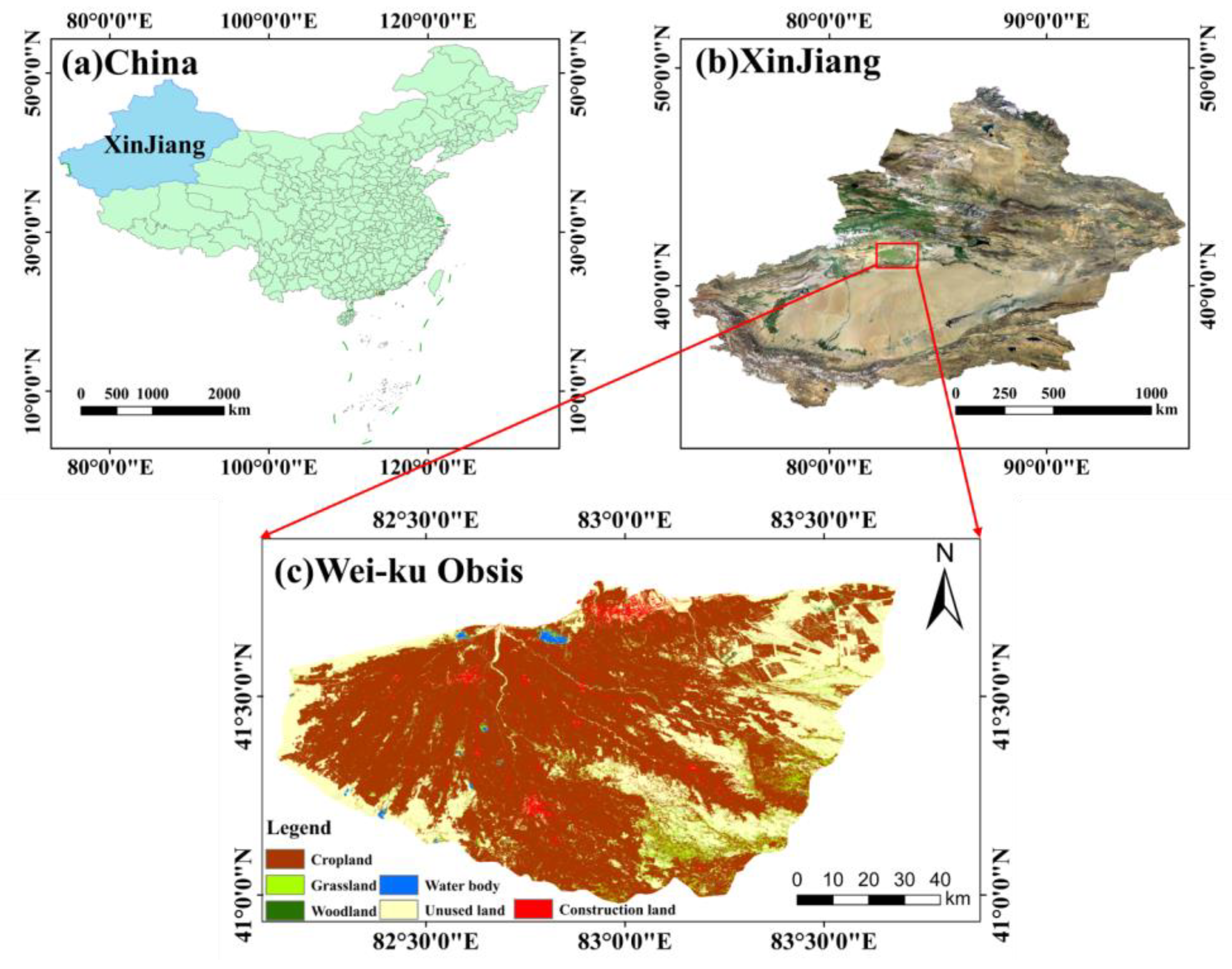

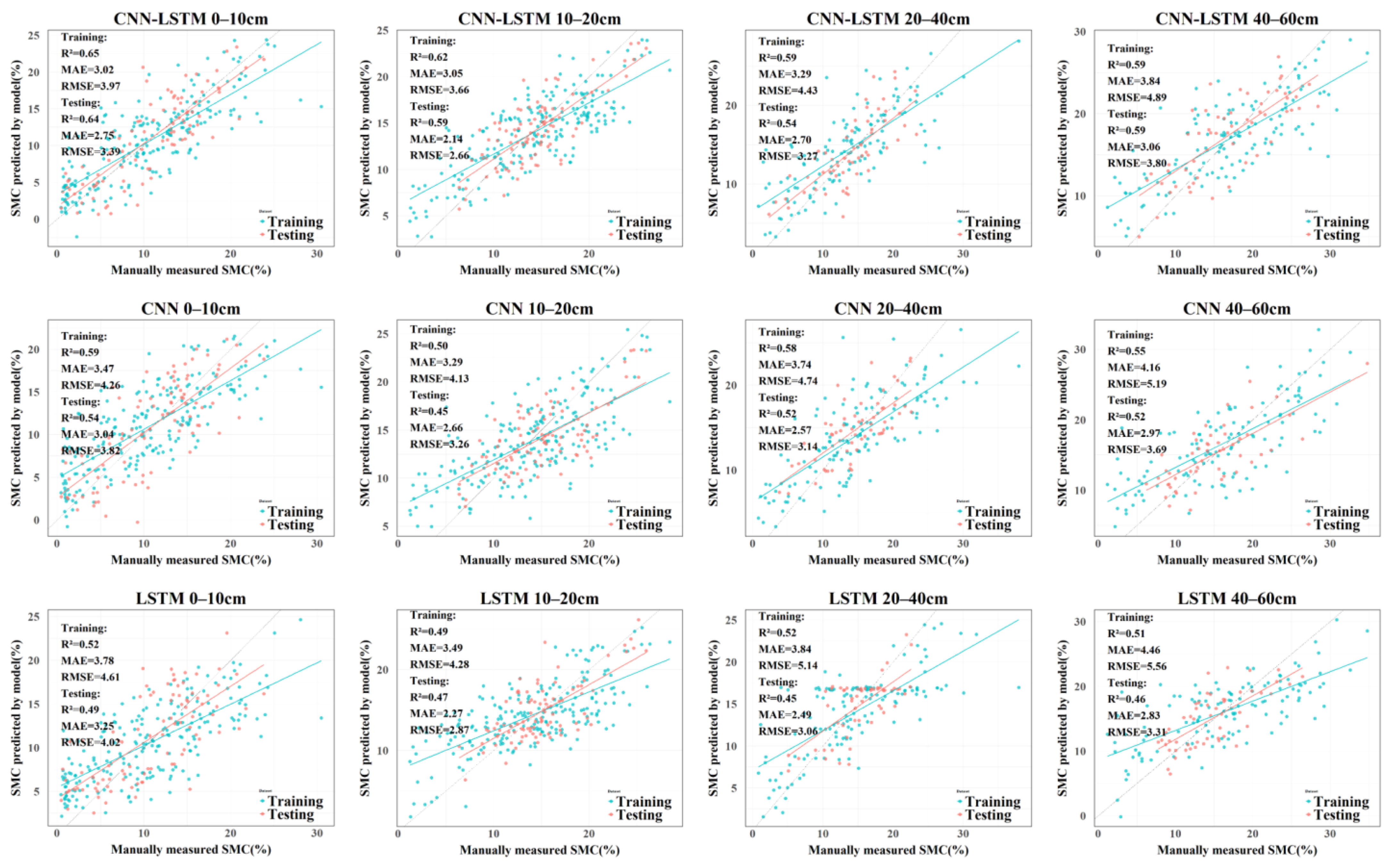
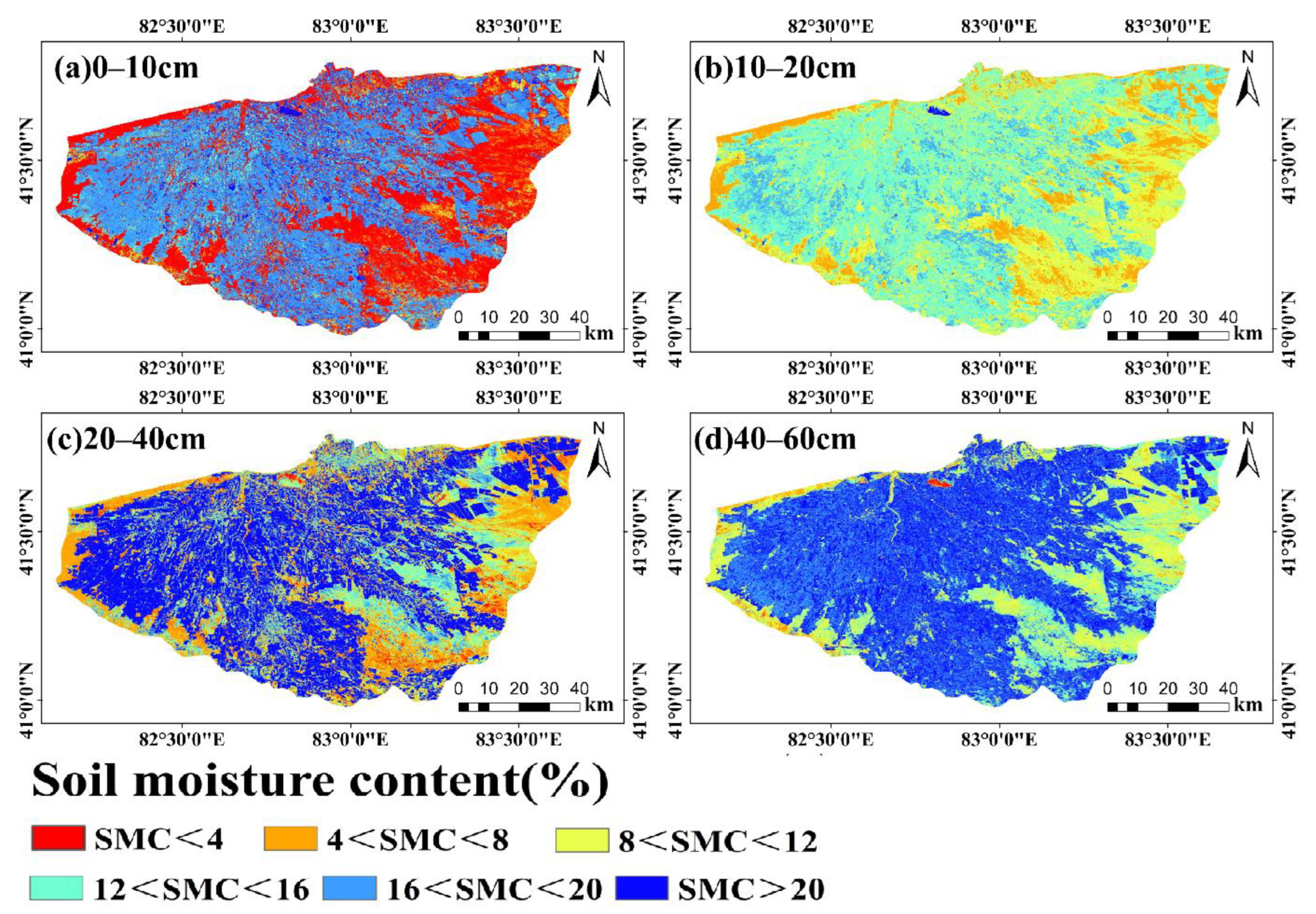
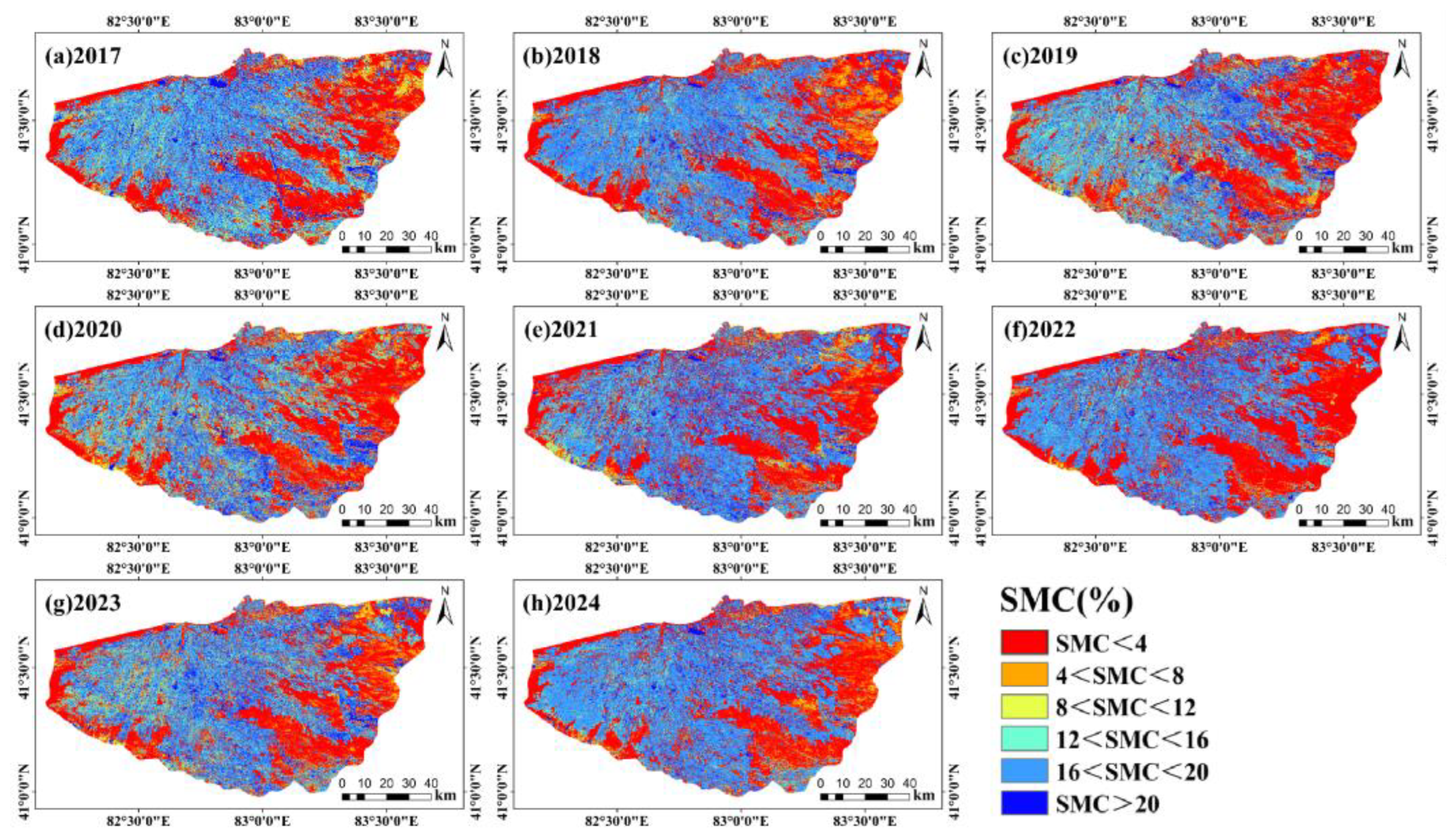
| Year | 0−10 cm | 10–20 cm | 20–40 cm | 40–60 cm |
|---|---|---|---|---|
| Sample | 303 | 299 | 190 | 173 |
| Index | Formula | Reference |
|---|---|---|
| Original band | [35] | |
| Normalized differential vegetation index (NDVI) | [36] | |
| Kernel Normalized Difference Vegetation Index (KNDVI) | [37] | |
| Enhanced vegetation index (EVI) | [38] | |
| Fusion vegetation index (FVI) | [39] | |
| Green Leaf Index (GLI) | [40] | |
| Global Vegetation Moisture Index (GVMI) | [41] | |
| Combined Spectral Response Index (COSRI) | [41] | |
| Atmospherically Resistant Vegetation Index (ARVI) | [42] | |
| Soil-Adjusted Vegetation Index (SAVI) | [43] | |
| Modified Soil-Adjusted Vegetation Index (MSAVI) | [42] | |
| Optimized Soil-Adjusted Vegetation Index (OSAVI) | [44] | |
| Modified Simple Ratio (MSR) | [45] | |
| Near-Infrared Reflectance of Vegetation (NIRv) | [46] | |
| Near-Infrared Normalized Index (NNIR) | [47] | |
| Red Nommalized Index (NR) | [48] | |
| Difference Vegetation Index (DVI) | [42] | |
| Renormalized Difference Vegetation Index (RDVI) | [45] | |
| Ratio vegetation index (RVI) | [49] | |
| Infrared position vegetation index (IPVI) | [50] | |
| Visible and shortwave infrared drought index (VSDI1) | [51] | |
| Visible and shortwave infrared drought index (VSDI2) | [51] | |
| Temperature Vegetation Dryness Index (TVDI) | [52] | |
| Normalized Multi-band Drought Index (NMDI) | [48] | |
| Normalized Difference Water Index (NDWI) | [53] | |
| Normalized Difference Moisture Index (NDMI) | [54] | |
| Modified Normalized Difference Water Index (MNDWI) | [53] | |
| Vegetation water supply index (VSWI) | [55] | |
| Normalized Difference Built-up Index (NDBI) | [54] | |
| Normalized Difference Bareness Index (NDBSI) | [56] | |
| Tasseled Cap Brightness (TCB) | [57] | |
| Tasseled Cap Greenness (TCG) | [57] | |
| Tasseled Cap Wetness (TCW) | [57] | |
| Land Surface Temperature (LST) | [52] | |
| Vertical transmit and vertical receive (VV) | [58] | |
| Vertical transmit and horizontal receive (VH) | [58] | |
| SUM_VVVH | [58] | |
| R_VHVV | [58] | |
| ND_VVVH | [58] | |
| D_VVVH | [58] | |
| SR_VHVV | [58] |
| Soil Properties | Minimum (%) | Maximum (%) | Mean (%) | Median (%) | Standard Deviation (%) | Coefficient of Variation (%) | Skewness |
|---|---|---|---|---|---|---|---|
| 0–10 cm | 0.43 | 30.47 | 10.60 | 10.48 | 6.39 | 60.29 | 0.23 |
| 10–20 cm | 1.23 | 28.43 | 14.31 | 14.53 | 5.47 | 38.23 | −0.13 |
| 20–40 cm | 0.81 | 37.91 | 14.76 | 14.37 | 6.64 | 44.96 | 0.23 |
| 40–60 cm | 1.18 | 34.80 | 15.78 | 15.54 | 7.14 | 45.25 | 0.15 |
| Deep/cm | Number of Features | Optimal Feature Combination |
|---|---|---|
| 0–10 | 6 | Green, FVI, GVMI, NDMI, NDVI, SUM_VVVH |
| 10–20 | 9 | Blue, SWIR2, COSRI, NNIR, RDVI, SAVI, SUM_VVVH, TCW, VSDI2 |
| 20–40 | 8 | LST, NDBI, NDMI, NDVI, SAVI, SUM_VVVH, VH, VV |
| 40–60 | 6 | SWIR2, GVMI, MSR, TCB, TCW, VV |
| Network type | Layers | Kernel Size | Hidden_Size (L) | Activation Functions |
|---|---|---|---|---|
| CNN | Convolutional | 3 | ReLU | |
| Convolutional | 3 | ReLU | ||
| Pooling | 2 | |||
| Fully connected | 1 | ReLU | ||
| LSTM | LSTM | 64 | Sigmoid, Tanh | |
| Fully connected | 1 | ReLU | ||
| CNN-LSTM | Convolutional | 3 | ReLU | |
| Convolutional | 3 | ReLU | ||
| Pooling | 2 | |||
| LSTM | 50 | Sigmoid, Tanh | ||
| Fully connected | 1 | ReLU |
| Deep/cm | Model | Train | Test | ||||
|---|---|---|---|---|---|---|---|
| R2 | MAE (%) | RMSE (%) | R2 | MAE (%) | RMSE (%) | ||
| 0–10 cm | CNN | 0.59 | 3.47 | 4.26 | 0.54 | 3.04 | 3.82 |
| LSTM | 0.52 | 3.78 | 4.61 | 0.49 | 3.25 | 4.02 | |
| CNN-LSTM | 0.65 | 3.02 | 3.97 | 0.64 | 2.75 | 3.39 | |
| 10–20 cm | CNN | 0.50 | 3.29 | 4.13 | 0.45 | 2.66 | 3.26 |
| LSTM | 0.49 | 3.49 | 4.28 | 0.47 | 2.27 | 2.87 | |
| CNN-LSTM | 0.62 | 3.05 | 3.66 | 0.59 | 2.14 | 2.66 | |
| 20–40 cm | CNN | 0.58 | 3.74 | 4.74 | 0.52 | 2.57 | 3.14 |
| LSTM | 0.52 | 3.84 | 5.14 | 0.45 | 2.49 | 3.06 | |
| CNN-LSTM | 0.59 | 3.29 | 4.43 | 0.54 | 2.70 | 3.27 | |
| 40–60 cm | CNN | 0.55 | 4.16 | 5.19 | 0.52 | 2.97 | 3.69 |
| LSTM | 0.51 | 4.46 | 5.56 | 0.46 | 2.83 | 3.31 | |
| CNN-LSTM | 0.59 | 3.84 | 4.89 | 0.59 | 3.06 | 3.80 | |
Disclaimer/Publisher’s Note: The statements, opinions and data contained in all publications are solely those of the individual author(s) and contributor(s) and not of MDPI and/or the editor(s). MDPI and/or the editor(s) disclaim responsibility for any injury to people or property resulting from any ideas, methods, instructions or products referred to in the content. |
© 2025 by the authors. Licensee MDPI, Basel, Switzerland. This article is an open access article distributed under the terms and conditions of the Creative Commons Attribution (CC BY) license (https://creativecommons.org/licenses/by/4.0/).
Share and Cite
Zhang, Z.; Wang, J.; Ding, J.; Zhang, J.; Li, L.; Shi, L.; Liu, Y. Spatiotemporal Mapping of Soil Profile Moisture in Oases in Arid Areas. Remote Sens. 2025, 17, 2737. https://doi.org/10.3390/rs17152737
Zhang Z, Wang J, Ding J, Zhang J, Li L, Shi L, Liu Y. Spatiotemporal Mapping of Soil Profile Moisture in Oases in Arid Areas. Remote Sensing. 2025; 17(15):2737. https://doi.org/10.3390/rs17152737
Chicago/Turabian StyleZhang, Zihan, Jinjie Wang, Jianli Ding, Jinming Zhang, Li Li, Liya Shi, and Yue Liu. 2025. "Spatiotemporal Mapping of Soil Profile Moisture in Oases in Arid Areas" Remote Sensing 17, no. 15: 2737. https://doi.org/10.3390/rs17152737
APA StyleZhang, Z., Wang, J., Ding, J., Zhang, J., Li, L., Shi, L., & Liu, Y. (2025). Spatiotemporal Mapping of Soil Profile Moisture in Oases in Arid Areas. Remote Sensing, 17(15), 2737. https://doi.org/10.3390/rs17152737








